Tim Havenith's Blog, page 6
February 9, 2024
𝐋𝐨𝐜𝐚𝐥 𝐆𝐫𝐞𝐞𝐧 𝐒𝐩𝐚𝐜𝐞𝐬 - Calne Community Neighbourhood Plan Survey
 The draft plan provided as part of this consultation is more aspirational than ever, with 28 proposed designations for Local Green Space in the town and villages within the area of the Calne Community Neighbourhood Plan.𝐆𝐢𝐯𝐞 𝐮𝐬 𝐯𝐨𝐮𝐫 𝐜𝐨𝐦𝐦𝐞𝐧𝐭𝐬 via on online survey by 𝐦𝐢𝐝𝐧𝐢𝐠𝐡𝐭 𝐨𝐧 𝐭𝐡𝐞 𝟐𝟐𝐧𝐝 𝐌𝐚𝐫𝐜𝐡 𝟐𝟎𝟐𝟒.Once you’ve read the Plan you can comment on all of it, or just on the parts that matter to you (questions can be skipped). Find out more: https://www.calnecommunityplan.com/𝐂𝐨... 𝐨𝐮𝐫 𝐬𝐮𝐫𝐯𝐞𝐲:https://survey.zohopublic.eu/zs/YNBuI... out our latest leaflet:https://bit.ly/CCNPR14
The draft plan provided as part of this consultation is more aspirational than ever, with 28 proposed designations for Local Green Space in the town and villages within the area of the Calne Community Neighbourhood Plan.𝐆𝐢𝐯𝐞 𝐮𝐬 𝐯𝐨𝐮𝐫 𝐜𝐨𝐦𝐦𝐞𝐧𝐭𝐬 via on online survey by 𝐦𝐢𝐝𝐧𝐢𝐠𝐡𝐭 𝐨𝐧 𝐭𝐡𝐞 𝟐𝟐𝐧𝐝 𝐌𝐚𝐫𝐜𝐡 𝟐𝟎𝟐𝟒.Once you’ve read the Plan you can comment on all of it, or just on the parts that matter to you (questions can be skipped). Find out more: https://www.calnecommunityplan.com/𝐂𝐨... 𝐨𝐮𝐫 𝐬𝐮𝐫𝐯𝐞𝐲:https://survey.zohopublic.eu/zs/YNBuI... out our latest leaflet:https://bit.ly/CCNPR14
February 5, 2024
𝐍𝐞𝐢𝐠𝐡𝐛𝐨𝐮𝐫𝐡𝐨𝐨𝐝 𝐏𝐥𝐚𝐧 𝟐 𝟐𝟎𝟐𝟑 - 𝟐𝟎𝟑𝟖: 𝐘
Have your say and respond to the consultation on the draft updated Calne Community Neighbourhood Plan.

This is part of our Regulation 14 consultation that is running between 𝟏𝐬𝐭 𝐅𝐞𝐛𝐫𝐮𝐚𝐫𝐲 - 𝟐𝟐𝐧𝐝 𝐌𝐚𝐫𝐜𝐡 𝟐𝟎𝟐𝟒 Your concerns and comments will help improve and finalise a Plan that gives our community a proactive and strong voice in the planning and development and protection of the town, villages, and natural environments of the Calne Community Plan Area. We also look to formalise the recognition of local historic assets and to ensure that we keep the 25% of Community Infrastructure Levy planning charge rather, which will drop to 15% without a Neighbourhood Plan.Find out more by visiting: https://www.calnecommunityplan.com/ 𝐂𝐨𝐦𝐩𝐥𝐞𝐭𝐞 𝐭𝐡𝐞 𝐬𝐮𝐫𝐯𝐞𝐲: https://survey.zohopublic.eu/zs/YNBuI6Check out our latest leaflet: https://bit.ly/CCNPR14Come along to one of the face-to-face events𝐅𝐫𝐢𝐝𝐚𝐲 𝟐𝟑𝐫𝐝 𝐅𝐞𝐛𝐫𝐮𝐚𝐫𝐲 - 𝟏𝟓.𝟑𝟎 - 𝟏𝟖.𝟑𝟎 𝐂𝐚𝐥𝐧𝐞 𝐋𝐢𝐛𝐫𝐚𝐫𝐲𝐒𝐚𝐭𝐮𝐫𝐝𝐚𝐲 𝟐𝟒𝐭𝐡 𝐅𝐞𝐛𝐫𝐮𝐚𝐫𝐲 - 𝟏𝟎.𝟑𝟎 - 𝟏𝟒.𝟎𝟎 𝐂𝐚𝐥𝐧𝐞 𝐓𝐨𝐰𝐧 𝐇𝐚𝐥𝐥𝐒𝐚𝐭𝐮𝐫𝐝𝐚𝐲 𝟐𝐧𝐝 𝐌𝐚𝐫𝐜𝐡 - 𝟏𝟎.𝟑𝟎 - 𝟏𝟒.𝟎𝟎 𝐋𝐚𝐧𝐬𝐝𝐨𝐰𝐧𝐞 𝐇𝐚𝐥𝐥, 𝐏𝐞𝐫𝐫𝐲 𝐋𝐚𝐧𝐞, 𝐃𝐞𝐫𝐫𝐲 𝐇𝐢𝐥𝐥
January 31, 2024
Place names of Calne: Brunel Way
Brunel was suggested as the name for this street as it is off Stanier Road. Sir William Stainer, was born in Swindon, where his father worked for the GWR[2], which was engineered by Isambard Kingdom Brunel - thereby making the connection between the two street names.
The GWR branch line to Calne was required because Brunel's choice of route missed Calne on the way to Chippenham. More than half of the funds required to build the railway came from the Harris family, who needed it to transport good from their factory.
The Calne branch saw its last passenger train on 18 September 1965 (freight traffic had ceased in 1964) and was dismantled two years later.
In addition to his visionary work on the GRW, Brunel is known for many other projects, which include the Clifton Suspension Bridge and three shops, Great Western, Great Britain and the iron sailing steamship, SS Great Eastern[3].
References:
[1] Giant Peach Design - giantpeach.agency. 2019. GreenSquare Group: New home is 'dream come true' for Calne family. [ONLINE] Available at: https://www.greensquaregroup.com/news/new-home-is-dream-come-true-for-calne-family2. [Accessed 18 September 2019].
[2] Wikipedia. 2019. William Stanier - Wikipedia. [ONLINE] Available at: https://en.wikipedia.org/wiki/William_Stanier. [Accessed 18 September 2019].
[3] Wikipedia. 2019. Isambard Kingdom Brunel - Wikipedia. [ONLINE] Available at: https://en.wikipedia.org/wiki/Isambard_Kingdom_Brunel. [Accessed 18 September 2019].
December 31, 2023
Place Names of Calne: Braemor Road

Braemor Road was built, along with Corfe Crescent c. 1960s. It is a development of primarily 3 bedroom semi-detached and terraced housing.
The name seems to be conflated and abbreviated from the names of the builders, the Property Register only lists Morley, however in private conversations the name 'Bradley' has been recollected. There a precedents for this name in Churchtown, Dublin, in the 1940s and 1950s[1], which is perhaps where Morley, a Bristol-based builder, got the idea.
References:
[1] Wikipedia. 2019. Churchtown, Dublin - Wikipedia. [ONLINE] Available at: https://en.wikipedia.org/wiki/Churchtown,_Dublin. [Accessed 17 September 2019].
November 30, 2023
Place Names of Calne: King Edward Close Development
 Charlotte CourtThe development at King Edward Close was completed by Hills Property[1] c. 2005 and built upon land that was previously used as allotments since at least 1899[2]. This was controversial at the time, as Calne Town Council sold the beloved allotments for housing. However, Hill agreed to leave some land for the allotments and the council achieved £1.2 million which went towards building the Beversbrook Sports Facility.
Charlotte CourtThe development at King Edward Close was completed by Hills Property[1] c. 2005 and built upon land that was previously used as allotments since at least 1899[2]. This was controversial at the time, as Calne Town Council sold the beloved allotments for housing. However, Hill agreed to leave some land for the allotments and the council achieved £1.2 million which went towards building the Beversbrook Sports Facility.Within this development ranging from maisonettes to 3 bed town houses, are a set of other Courts. At first, I thought that there may be a connection between the Courts of Falstaff, Savoy, and Globe pointing towards Shakespeare. However, I posed the question to the followers of my Facebook page, Calne Place Names, where I was quickly told of a much more sound theory[3].
So, for the full run down:
Garden Court: Garden is a commonly used term for land that was used for horticulture, or adjoining a domestic garden[4]. As we know that this land was an allotment, the choice of this name is clear.
All of the following street names relate to varieties of vegetables:
King Edward Close, is the main road for this development and connects Swaddon Street and Ridgemead.
Charlotte Court
Falstaff Court
Globe Court
Savoy Court
Interestingly, about 10 miles north of Calne, the village Great Somerford, Wiltshire has the accolade of having the oldest allotments in Britain. The parish rector for Great Somerford, also the chaplain to King George III, requested that some land in his parish be set aside from the enclosure of 1809. A field of 6 acres was set aside, ensuring that the poor still had land for personal cultivation[5].
References:
[1] Planning application N/03/03109/ADV
[2] OS Map, 1899/1900, Wiltshire XXVII.1, Ordnance Survey.
[3] Facebook. 2019. Facebook. [ONLINE] Available at: . [Accessed 17 September 2019].
[4] Cavill, P., 2018. A New Dictionary of English Field-Names. 1st ed. Great Britain: English Place-Name Society.
[5] Wikipedia. 2019. Great Somerford - Wikipedia. [ONLINE] Available at: https://en.wikipedia.org/wiki/Great_Somerford#Allotment_gardens. [Accessed 01 October 2019].
October 31, 2023
Place Names of Calne: Curzon Street, Curzon Close
 No. 6, Curzon Street.The name Curzon is an Anglo-Norman surname that can be traced back to Notre-Dame-de-Courson, in Calvados, France[1]. This former commune was itself was named with the personal name of Curtius, which is Romano-Gallic for 'short'[2]. The Curzon name came to England when members of that family accompanied their overlords, the barony of the Ferrers to England as part of the Norman conquest[3].
No. 6, Curzon Street.The name Curzon is an Anglo-Norman surname that can be traced back to Notre-Dame-de-Courson, in Calvados, France[1]. This former commune was itself was named with the personal name of Curtius, which is Romano-Gallic for 'short'[2]. The Curzon name came to England when members of that family accompanied their overlords, the barony of the Ferrers to England as part of the Norman conquest[3].Curzon Street is one of the very early streets in Calne, known as Cusinstret in 1245[2]. Around this time, Walteri Thurgod, who held a burgage, and William and his wife, Edith, who held a messuage, both endowed Stanley Abbey with the charters for their land on Curzon Street[3].
The name continued to change over time, being Cosenstrete in 1536, Cowsyn strete in 1548, Cozen Strett in 1695, Cossen Street in 1728[6], and finally Curzon Street in the 1828 map by Thomas Cruse.
A short History of Curzon Street
From the earliest maps we can see that Curon Street begins at The Square and is the main road out of Calne towards Studley. Grade II* listed Number 6 is one of the oldest buildings in Calne, dated 1617 in brick just below the chimney.
St. Cecilia's: However it is Grade II* listed numbers 5 and 7, known as St. Cecilia's House and dating from 1743, that has a much more interesting history. 1829 saw Dr. George Shadforth Ogilvie renting before purchasing the house, then known as Northfield House, from his mother-in-law. He developed the house to be multifunctioning: a home, a surgery, and by 1833, a lunatic asylum. An 1839 advert details that while paupers were excluded, Ogilvie's method was "uniformly one of kindness and conciliation"[7]. This asylum was the first local service for mental illness patients and was operated by Ogilvie until 1845, when he moved to Bristol.
It was a Dr. Pownall that purchased the house and set up his medical services there, and was certainly seeing "Mentally Afflicted and Nervous Patients" by June 1850[8]. 1859 saw Pownall himself suffer a mental affliction while living with his wife, sister and his 80 year old mother-in-law. He beat his mother-in-law, who miraculously survived. Found by Dr. Morris, who found that Pownall had swalled chloroform with the intention of killing himself, all Pownall could say on the matter is that the woman 'annoyed him'[9]. He was sectioned at Northwoods asylum near Bristol and had apparently recovered after four months and was discharged to Mr. Leete, a surgeon and colleague in Lydney. Sadly on 30 August 1859, Pownall murdered servant Louisa Cooke, was declared insane was eventually moved to Broadmoor and died on 11 December 1882, still an inmate as nobody would risk his released even though he never showed signs of mental health issues again.
St. Mary's School purchase half of the house from Mr. Redman in 1943, and was able to purchase the rest in 1947, at which point it was renamed St. Cecilia's, following the school's tradition of naming buildings after saints. These days the house is home to 49 boarders of St Mary's school, with restoration work carried out in 2003 and 2014[10].
 The Post Office, constructed of Cotswold Dale stone by Messrs. Holborow of Tetbury, was opened on Monday, 2 February 1953 as the first to bear the Royal EIIR cipher in the South West (if not the country)[11]. The post office is no long located here, however the sorting office still operates at the rear of the building.
The Post Office, constructed of Cotswold Dale stone by Messrs. Holborow of Tetbury, was opened on Monday, 2 February 1953 as the first to bear the Royal EIIR cipher in the South West (if not the country)[11]. The post office is no long located here, however the sorting office still operates at the rear of the building.13 Curzon Street was operated by Cooper's garage from c. 1940s until 1995, when Thomas's of Calne took over the site, prior to this the site was Parkhouses' slaughter house. See Thomas Court for more information.
White Horse Veterinary Surgery at 15 Curzon Street occupies a Grade II listed early 1700s house and shop. In the past the single storey part has been a butcher's shop operated by Frederick Richards in the early 1900s, the local Labour Exchange, and Calne Premier Press during the 1960s-80s.
1822 saw The Wheatsheaf open, with lighting in 1844 and sewers following in 1858[12]. Hungerford Row, the lovely curved terrace of 15 cottages, opposite what is now Goldman's (previously Coopers Filling Station), was built between 1817 and 1828.
 Hungerford Row, Curzon Street
Hungerford Row, Curzon StreetIn 1828, H. A. Merewether, had Castlefield House built in a 33 acre park[13]. Both Castlefield and the Lodge that led to the house (76 Curzon Street) are discussed in posts on Castlefields and Lodge Close.
St. Mary's moved from their home on The Green in 1908 and have purchased and built many buildings in the ground since that time. The purchased and demolished the enourmous Calne Union Workhouse, known at Northfields, c.1938, however the entrance lodge remains. The isolation hospital, built in 1888, was converted for St. Margaret's c.1945.
On the grounds of St. Mary's is also a listed lime kiln and the remains of a quarry. The quarry was still in use during WWII, when German POWs from Yatebury Camp worked it.
c. 2010 Westlea Housing built the Park View Terrace development.
Curzon Street Cemetery was opened in 1867 for Non-Conformist burials, which includes that of Thomas Harris and his wife Elizabeth. It is still open as of 2019.
Hermitage Cottages (56-62 Curzon Street) were built in the mid-1800s. This area was known as The Hermitage in the early 1800s made up of two farmsteads or businesses, which included a barn, stable and cart house. From that time, it seems that no. 68 is the only survivor of that period[14]. However, it seems that Castlefield House may have also gone by the name of The Hermitage too, perhaps due to the area being known by the same name and Henry Merewether owning both. In a letter between William Lisle Bowles and Caroline Bowles, in which Caroline is seeking a suitable house for her friend Lady Davenport, William recommends the house belonging to Mr Sergeant Merewether, with a "most excellent & well-laid-out Garden". Bowles goes on to call this villa Calne Hermitage[15]. Castlefields was built by this time, and is likely to be the villa being discussed.
Springfield, the Grade II listed house was built c. 1820 for grocer, William Gundry and at one time was owned by the Harris family. It was formerly known as Greenacres and is now part of Springfields Academy, a state school for girls and boys aged 5-19 that provides Special Education Needs for Autistic Spectrum Disorder along with emotional, communication, and learning difficulties.
Widening the A4
Looking back towards the beginning of Curzon Street from Goldman's the street would have been much different as around 20 houses in this area including the house that was next to 5 Market Hill, were demolished. This happened in 1968 to enable the much-needed widening of Curzon Street, which included demolition of the three-storey Plume of Feathers public house.
By 1964 many houses were already vacant due to Closing Orders. In 1964 the Medical Officer for Health reported "Curzon Street is potentially a dangerous thoroughfare to motor vehicles, pedestrians, and to the population living in the properties facing the road"[16]. The road width was very variable, as was the path width, some pavements being as little as 2'2", which would have worried pedestrians as heavy vehicles were mounting pavements on a daily basis. The four years prior to 1968 had seen 26 accidents involving motor vehicles, however this was only the number actually reported to Calne Police Station and likely was not the full total.
While the demolition of so many buildings was a loss to the town, it did allow the widening of the road, which opened up the area and increased the town's green space, known as Town Gardens. It is a well used park, particularly on Bike Meet day, which is well maintained with grass and flower displays. It's a delight to walk - or drive - past.
 Curzon CloseCurzon Close, is part of the Curzon Park Estate first developed c. 1983, however further development was approved for Oakus Housing in 2007. This saw the demolition of some existing building and the erection of 9 Dwellings (7 Terraced Houses and 2 Flats) and 6 Garages[17].
Curzon CloseCurzon Close, is part of the Curzon Park Estate first developed c. 1983, however further development was approved for Oakus Housing in 2007. This saw the demolition of some existing building and the erection of 9 Dwellings (7 Terraced Houses and 2 Flats) and 6 Garages[17]. References:
[1] Pine, L., 1966. The story of surnames. 1st ed. London: Country Life Ltd.
[2] Curzon Name Meaning & Curzon Family History at Ancestry.co.uk®. 2019. Curzon Name Meaning & Curzon Family History at Ancestry.co.uk®. [ONLINE] Available at: . [Accessed 17 September 2019].
[3] Wikipedia. 2019. Notre-Dame-de-Courson - Wikipedia. [ONLINE] Available at: https://en.wikipedia.org/wiki/Notre-Dame-de-Courson. [Accessed 17 September 2019].
[4] Gover, J., Mawer, A. and Stenton, F. (1970). The place-names of Wiltshire. Cambridge: At the University Press.
[5] Birch, W. (1875). Collections towards the History of the Cistercian Abbey of Stanley, in Wiltshire. The Wiltshire Archaeological and Natural History Magazine, XV.
[6] 1728 Map of Wiltshire. Seen at Calne Heritage Centre.
[7] n.n (1839) 'INSANITY' Bath Chronicle and Weekly Gazette, 11 April 1839. Available at: https://www.britishnewspaperarchive.co.uk/viewer/bl/0000187/18390411/029/0001 [Accessed on 17 September 2019]
[8] n.n (1850) 'MENTAL AFFLICTION' Salisbury and Winchester Journal, 29 June 1850. Available at: https://www.britishnewspaperarchive.co.uk/viewer/bl/0000361/18500629/020/0001 [Accessed on 17 September 2019]
[9] Vaughan, D., 2017. Mad or Bad: Crime and Insanity in Victorian Britain. 1st ed. UK: Pen & Sword History.
[10] Wiltshire Times. 2019. Hidden history of home from home | Wiltshire Times. [ONLINE] Available at: https://www.wiltshiretimes.co.uk/news/11660918.hidden-history-of-home-from-home/. [Accessed 17 September 2019].
[11] Wiltshire Times and Trowbridge Advertiser. 31 January 1953.Calne's New Post Office. [ONLINE] Available at: https://www.britishnewspaperarchive.co.uk/viewer/bl/0001671/19530131/143/0005. [Accessed 17 September 2019].
[12] Calne: The town in the 19th century | British History Online. 2019. Calne: The town in the 19th century | British History Online. [ONLINE] Available at: https://www.british-history.ac.uk/vch/wilts/vol17/pp41-44#highlight-first. [Accessed 17 September 2019].
[13] Calne: The town in the 19th century | British History Online. 2019. Calne: The town in the 19th century | British History Online. [ONLINE] Available at: https://www.british-history.ac.uk/vch/wilts/vol17/pp41-44#highlight-first. [Accessed 17 September 2019].
[14] Calne: The town to c.1800 | British History Online. 2019. Calne: The town to c.1800 | British History Online. [ONLINE] Available at: https://www.british-history.ac.uk/vch/wilts/vol17/pp34-41#highlight-first. [Accessed 17 September 2019].
[15] Moody, R., 2009. The Life And Letters Of William Lisle Bowles, Poet And Parson, 1762-1850. Hobnob Press.
[16] Broomhead, C.L., 1965. The Annual Report of the Medical Officer of Health and Senior Public Health Inspector for the Year Ended 31st. December 1964.
[17] Planning application N/07/02450/CAC
September 30, 2023
Place Names of Calne: Nestleton Close
 Nestleton Villa, Calne. Undated map. Courtesy of Calne Heritage Centre.
Nestleton Villa, Calne. Undated map. Courtesy of Calne Heritage Centre.
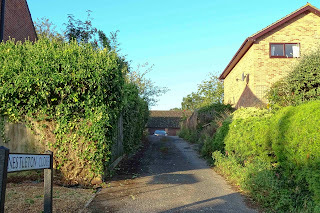 Nestleton CloseNestleton Close is on the grounds of Nestleton Villa, which was located off Back Road (also known as Back Row).
Nestleton CloseNestleton Close is on the grounds of Nestleton Villa, which was located off Back Road (also known as Back Row).On Monday, 8 September 1930, the villa with its three reception rooms, six bedrooms, and two summerhouses, was to be offered for sale by auction by Thompson and Noad[1].
Linden Close, which leads to Quarrydale Close and Nestleton Close was built in the 1960s, but the maps I have available don't show Nestleton Close until the 1980s.
[1] [11] Wiltshire Times and Trowbridge Advertiser. Saturday 06 September 1930. Thompson & Noad. [ONLINE] Available at: https://www.britishnewspaperarchive.c.... [Accessed 17 September 2019].
July 31, 2023
Place Names of Calne: Post-war Housing Scheme (Abberd Estate)
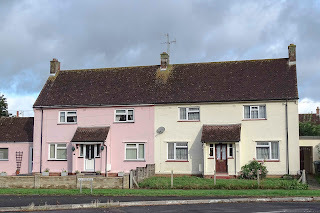 Abberd WayCalne borough council built housing on Abberd Way from 1945s[1]. This was due to the urgent need for housing that was identified in the early 1940s[2], but postponed in October 1940 due to the critical circumstances of the war making it necessary to cut expenditure where possible[3].
Abberd WayCalne borough council built housing on Abberd Way from 1945s[1]. This was due to the urgent need for housing that was identified in the early 1940s[2], but postponed in October 1940 due to the critical circumstances of the war making it necessary to cut expenditure where possible[3].It was planned that work on the sewers and road would start on 2 June 1945, but owning to labour shortage this didn't happen[4]. Therefore arrangements were made that meant the construction of the roads, sewers, and surface water drains were completed by around 60 German prisoners-of-war[5] (probably from the POW camp in Yatesbury, which housed around 800 Germans)[6].
A newspaper article of May 1946 reports that the Ministry of Health had consented to Calne town council accepting a negotiated tender of £23,850 for the erection of 22 houses at Abberd, however, the builder(s) in question are not named[7].
By 1949, 78 houses had been built, with another 24 under construction at that time[8]. 1949 also saw the provision of electric street lamps, with 44 divided between "Wood Street, Oxford Road, Oxford Road to the Abberd housing site, Abberd Way, The Pippin, Cop Croft and Zion Lane", with councillor H. Cooper stating that the lighting scheme was a "dire necessity"[9]. These lamps tended to be installed on concrete posts, I don't think there are any of these remaining on the streets mentioned above.
The post-war housing scheme at Abberd extended to Honey Garston and The Slades. Penn Hill Road and Woodhill Avenue, of similar design, must have been a continuation of the post-war building.
Also in 1945 there were negotiations with a Mr. Henly, the owner of the field Bryant's Close. At the time of the news report, the land was an expensive £350 per acre, which over 17 acres would cost around £6000, which would lead to around 150 much needed houses. I cannot find any details about the progression of any negotiations, but by 1960 around 275 houses had been built in the streets north of Bryans Close Road, which was on the south side of Bryants Close field and had 50 houses in the 1930s[10].
References:
[1] Calne: The town in the 20th century | British History Online. 2019. Calne: The town in the 20th century | British History Online. [ONLINE] Available at: https://www.british-history.ac.uk/vch/wilts/vol17/pp44-51 . [Accessed 23 January 2019].
[2] Report of the Medical Officer of Health for the year ending 31st December 1943.
[3] n.n (1940) 'Housing scheme postponed' Wiltshire Times and Trowbridge Advertiser, 19 October 1940. Available at: https://www.britishnewspaperarchive.co.uk/viewer/BL/0001557/19401019/113/0003?browse=False [Accessed on 05 September 2019]
[4] n.n (1945) 'Housing Report' Wiltshire Times and Trowbridge Advertiser, 16 June 1945. Available at: https://www.britishnewspaperarchive.co.uk/viewer/BL/0001557/19450616/182/0008?browse=False [Accessed on 05 September 2019]
[5] Report of the Medical Officer of Health for the year ending 31st December 1945.
[6] The Wiltshire Gazette and Herald. 2019. Calne children help in dig to discover more about prisoner of war camp | The Wiltshire Gazette and Herald. [ONLINE] Available at: https://www.gazetteandherald.co.uk/news/9965786.calne-children-help-in-dig-to-discover-more-about-prisoner-of-war-camp/. [Accessed 24 July 2019].
[7] n.n (1946) 'Houses to be built at Calne' Wiltshire Times and Trowbridge Advertiser, 18 May 1946. Available at: https://www.britishnewspaperarchive.c... [Accessed on 05 September 2019]
[8] Report of the Medical Officer of Health for the year ending 31st December 1949.
[9] n.n (1946) 'Street Lighting' Wiltshire Times and Trowbridge Advertiser, 15 October 1949. Available at: https://www.britishnewspaperarchive.co.uk/viewer/bl/0001557/19491015/083/0003 [Accessed on 05 September 2019]
[10] Calne: The town in the 20th century | British History Online. 2019. Calne: The town in the 20th century | British History Online. [ONLINE] Available at: https://www.british-history.ac.uk/vch/wilts/vol17/pp44-51. [Accessed 05 September 2019].
June 20, 2023
Route 017: Windmill Mill and the Long stones
A circular route taking in the neolithic Windmill Hill, taking in stunningly expansive views before dropping back down into Avebury Trusloe via 'Adam' and 'Eve' the only surviving long stones of a suspected prehistoric stone avenue.

Important information:
Parking is located to the south-west of the village on the A4361. Sat Nav postcode: SN8 1RD. This parking is free for National Trust and English Heritage members. There is a cost for those that are not members of these organisations. Please check the National Trust website for updated information.
Due to uneven ground, stiles (including a bridge with multiple stiles), and difficult terrain, this trail is not considered accessible, particularly for those that use wheelchairs, pushchairs, etc.
There are two shortcuts available that will shorten the trail down to around 7km, with the full trail being closer to 8km.
This is a walk that could be a book itself. Therefore, I have restricted the amount of text on the history to ensure that the walk flows. I would recommend the book Exploring Avebury by Steve Marshall, available at the Henge Shop and online, for anyone that would like to know more.
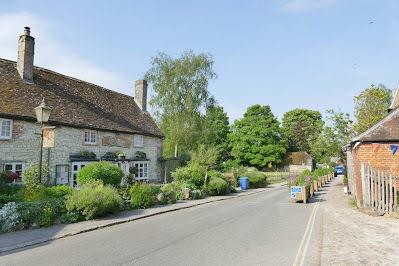
1) This walk starts at the wonderfully eclectic Henge Shop on High Street, which can be reach via a short walk from the National Trust car park.
From here walk westerly along High Street to the early 18th Century whitewashed sarsen thatched cottages to the right of way path (AVEB32) to the right. This will lead you into the churchyard of Grade I listed, St. James.
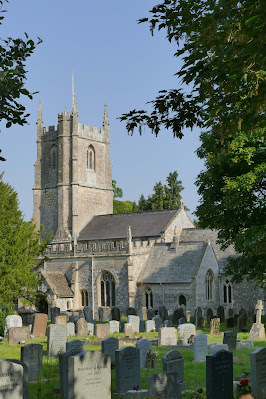 St. James dates back to as early as the 10th Century, including a late Anglos-Saxon nave, with restorations and improvements in almost every century since. The tower includes eight bells, known as a full circle ring, and a clock bell, which happens to be the oldest of the bells, dated to 1710 and the foundary of Richard Phelps who is thought to have cast 204 bells in his career spanning from 1700-1738.
St. James dates back to as early as the 10th Century, including a late Anglos-Saxon nave, with restorations and improvements in almost every century since. The tower includes eight bells, known as a full circle ring, and a clock bell, which happens to be the oldest of the bells, dated to 1710 and the foundary of Richard Phelps who is thought to have cast 204 bells in his career spanning from 1700-1738.

2) Take a left through the gateway after the cottages on your left to the path (AVEB31). This will turn into a wide bridleway, known as Church Walk, leading you over two small bridges, the second spans the River Kennet. This will give you the first views of the countryside, which include the first view of Silbury Hill.

3) After the River Kennet crossing, follow the path to the right. Then take the stile to your right, signed Windmill Hill.
Crossing this field will bring you to a wooden bridge with stiles at each end. You are effectively crossing back over the River Kennet.
After the bridge, head north keeping the Kennet to your right, towards the gap in the hedging.
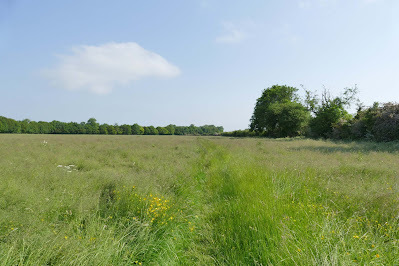
4) The next field is more expansive, follow the well-trodden path, which will lead you to the northern end of the field.
Cross over the stile into Sloe copse and heading out through the metal kissing gate.
Follow the desire line path and as you progress, keep the hedge to your left. In the spring, this is a beautiful field, filled with buttercups.
Taking the kissing gate and heading left will begin the advance to Windmill Hill along the White Horse Trail and the dividing line between the parishes of Avebury and Winterbourne Monkton.

5) The final field leading up to the hill is a joy to walk during the spring and summer. Filled with wildflowers and pollinators galore, with views to die for, including another glimpse of the ever-mysterious Silbury Hill.

6) Take a moment as you pass through the gate into Windmill Hill, a place that was active over 5000 years ago.
This is a landscape of superlatives: Windmill Hill is the largest causewayed enclosure in Britain. Silbury Hill is largest artificial mound in Europe as the Avebury stone circle is the largest prehistoric stone circle in the world.
Assumed to be an expansive sacred and ceremonial landscape, this is half of the Stonehedge and Avebury World Heritage Site. The 25 square kilometres of the Avebury portion of this listing include many complex ancient monuments.
Windmill Hill is thought to be the earliest site of the complex and held ritual activity around 3700BCE. Not long afterwards, perhaps as little as 50 years, West Kennet Long Barrow was built and would become one of the largest chambered tombs in Britain, and the resting place of nearly 50 people. It would be hundreds of years before the construction of the Avebury henge and stone circles began, between 2850BCE - 2200BCE. It was during this time period, around 2400BCE that Silbury Hill was completed.
Windmill Hill is at its most spectacular from the sky, where the earthworks can be viewed in all of their splendor. However, this is not how the people who created this causewayed enclosure would have viewed constructions.
Archaeological evidence points to this enclosure being used occasionally for around 300 years, perhaps for trade and feasting, with evidence of animals consumed at the site.
Alexander Kieller, who we will discover more about later, discovered three concentric rings in the 1920s, which were refilled in the 1950s, making them difficult to see today. In addition, Kieller, who first assessed the hill by making aerial observations, went on to excavate the site with impressive finds, such as flint tools, human and animal bones, and pottery, which became known as Windmill Hill ware, which was subsequently also found at Silbury Hill, making it reasonably likely that it was the same community that created both monuments.
From the gate you are presented with a bronze age bowl barrow and two options.
Heading south-westerly, with the fences to your left, will lead you to the exit of Windmill Hill. This is represented by the blue-dash line on the map.
Alternatively, pass over or around the barrow experience more of the site and the impressive views. All of the barrows you see are later additions to the site, with the inner ditch with a raised feature is the 'centre' of the enclosure.
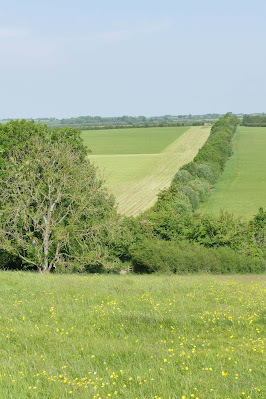
7) When you are finished exploring the site, follow the trail southwesterly down the decline to the gate. Turn left onto the byway (CHER18), with the Windmill Hill plantation to your left - taking care with the ruts left by vehicles.
At the junction take the byway to the left (AVEB19) which will take you up to yet more impressive views, including the Lansdowne Monument.
Shortly, you will pass the exit from Windmill Hill mentioned in the shortcut of Instruction 6.
Follow the curves of this byway for around 1.5km crossing over Horslip Bridge and towards Manor Farm.
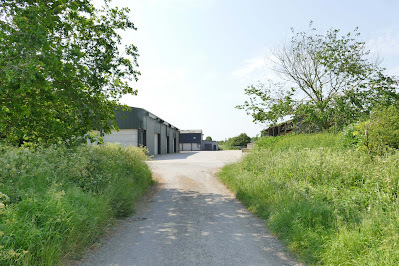
8a) At Manor Farm, you can take a shortcut to the left along Bray Street back to the bridges near the beginning of the walk. Join us at instruction 14.
8b) The longer route takes in the Long Stones, and can be reached by going straight across and past the farm buildings on to byway AVEB14, which is voluntarily closed to vehicles between 1 October and 30 April each year to protect the route.

9) Following the byway provides stunning and ever-changing views of the Long Stones, known as 'Adam' and 'Eve', with Adam being the larger of the two stones. It was Adam that fell over in 1911 and was re-erected in 1912 by Maud Cunnington, a Welsh archaeologist best known for her work on Salisbury Plain. During this time, Cunnington discovered a Beaker inhumation of a man, close to the stone and presumed to postdate this impressive megalith.
Both stones have been scheduled monuments since 1930, with Eve being considered to have been part of a 1300m long double stone row, called Beckhampton Avenue, with stones placed at 15m intervals leading to Avebury Henge from The Cove, of which only Adam remains. Stones have been found by excavation that have led to our current understanding, however, it remains out of reach as to why this route may have been a special route to and from the henge.

10) As you round the bend of the track, look to your right towards Longstones Barrow. Worth a few steps to see the massive bulk of this barrow, even though precious little evidence of use exists. An excavation occurred in 1850, but was poorly recorded, with perhaps a secondary cremation in a Biconical urn and possibly and associated dagger.
Return to the byway and continue onwards, passing Beckhampton Stables on your right.
This will lead you to Nash Road with views of Avebury Trusloe.

11) Avebury Trusloe is a modern settlement that sits some distance from the manor that it takes its name from. The housing is said to have been built to re-house those displaced from the demolitions within Avebury during Alexander Keiller's mission to restore the henge to its former neolithic glory.
Alexander Keiller (1889 - 1955) was a man of many talents and a varied career. From pioneering aerial photography, to becoming an expert in the field of fingerprint technology during his time as a Wiltshire Police Inspector. Keiller was heir to the family business, James Keiller & Son, established in 1797. In 1910, Keiller inherited the business and became a 'Marmalade Millionaire', leaving his uncle to the actual job of running the business, Keiller got back to his playboy activities, which included being married four times!
In 1915, Keiller was invalided out of WWI, leading him to join air intelligence and learn to fly and discover the landscape of the West Country before casting his eyes on Avebury.
In 1934, Keiller acquired 950 acres of Avebury and employed local workmen as part of his project. This restoration meant the removal of many cottages, farm buildings, fences, trees, and undergrowth - sometimes with the use of dynamite.
During the restoration project, 60 tons of grey sarcens were unearth and positioned in their original holes, before being set in cement.
WWII halted the re-building of the stone circle, after which ill-health prevented any additional works. Eventually, Keiller sold the land to the National Trust at agricultural rates before dying of cancer in October 1955.
In 1966, Keiller's fourth wife, Gabrielle Keiller gifted the museum and its contents to the nation.

12) At South Street, you will reach the houses, take a left after Stratton House. This footpath (AVEB27) will lead you diagonally to Bray Street South East. Cross the road heading towards the Right of Way markers. Take a right after the brick wall and follow the footpath (AVEB23) past Chapel Corner Barn and Chapel Cottages.

13) At the end of this section, go through the gate and follow the track, keeping the wire fence to your right and pass through the next gate.
Following the path will lead back to the bridges we crossed and the River Kennet.

14) After the bridges, you'll be back on Church Walk, following the bends in the road past the thatched cottages and the lych gate to St. James's church.
Upon returning to High Street and approaching the Henge Shop, look right to the henge itself.
You'll be able to view Stone 24 of the south-west quadrant. It's easy to see that this stone has been partially re-assembled from broken fragments that were used in a building. The resulting appearance is very artificial. Perhaps damaged stones are best left alone.
Thank you for using this route!
Words and Photographs: Tim HavenithMap from the lovely folks at OpenStreetMap. © OpenStreetMap contributors
May 31, 2023
Place Names of Calne: South Place
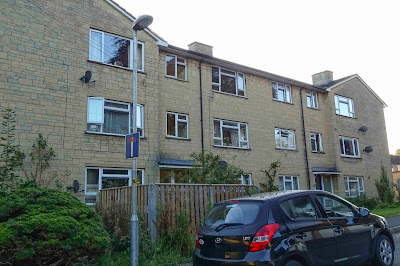 South PlaceIn February 1962, the house South Place was demolished, with the flats erected in the same decade.
South PlaceIn February 1962, the house South Place was demolished, with the flats erected in the same decade.South Place was a on the corner of Silver street and London road and the building may have had an 18th-Century core. It had a distinctive machicolated parapet, a large projection that curved around the north side of the building, which linked a warehouse on Silver street and a house on London road[1].
The house had an interesting history, from being the home of Abraham Henly, who used it as an outlet for wine and spirits, to being the home of Thomas Harris (of C&T Harris) and his family. Thomas Harris donated money that was used to open the recreation ground in Calne, which he did to celebrate his silver wedding anniversary to Elizabeth, his third wife. He was also a five time mayor for the town[2].
Between 1947 and 1962, it was the surgery for Dr. Alan Grant, who managed to buy the entire building in the mid-1950s. Sadly the building was in very poor condition and when it was demolished, Dr. Grant and his wife moved to the Coach House at Castlefields, now Grant House; while the surgery moved to Station Road, in a wooden hut[3].
References:
[1] Calne: The town in the 19th century | British History Online. 2019. Calne: The town in the 19th century | British History Online. [ONLINE] Available at: https://www.british-history.ac.uk/vch/wilts/vol17/pp41-44#anchorn38. [Accessed 03 September 2019].
[2] n.n (1917) 'Death of Mrs. Thomas Harris' Wiltshire Times and Trowbridge Advertiser, 12 May 1917. Available at: https://www.britishnewspaperarchive.c... [Accessed on 03 September 2019]
[3] Beale, N., 1998. Is that the Doctor?. 1st ed. Trowbridge: Cromwell Press.



